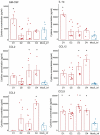Infection with Influenzavirus A in a murine model induces epithelial bronchial lesions and distinct waves of innate immune-cell recruitment
- PMID: 37649477
- PMCID: PMC10464834
- DOI: 10.3389/fimmu.2023.1241323
Infection with Influenzavirus A in a murine model induces epithelial bronchial lesions and distinct waves of innate immune-cell recruitment
Abstract
Introduction: Inflammatory lesions after Influenza A viruses (IAV) are potential therapeutic target for which better understanding of post-infection immune mechanisms is required. Most studies to evaluate innate immune reactions induced by IAV are based on quantitative/functional methods and anatomical exploration is most often non-existent. We aimed to study pulmonary damage and macrophage recruitment using two-photon excitation microscopy (TPEM) after IAV infection.
Methods: We infected C57BL/6 CD11c+YFP mice with A/Puerto Ricco/8/34 H1N1. We performed immune cell analysis, including flow cytometry, cytokine concentration assays, and TPEM observations after staining with anti-F4/80 antibody coupled to BV421. We adapted live lung slice (LLS) method for ex-vivo intravital microscopy to analyze cell motility.
Results: TPEM provided complementary data to flow cytometry and cytokine assays by allowing observation of bronchial epithelium lesions and spreading of local infection. Addition of F4/80-BV421 staining allowed us to precisely determine timing of recruitment and pulmonary migration of macrophages. Ex-vivo LLS preserved cellular viability, allowing us to observe acceleration of macrophage motility.
Conclusion: After IAV infection, we were able to explore structural consequences and successive waves of innate immune cell recruitment. By combining microscopy, flow cytometry and chemokine measurements, we describe novel and precise scenario of innate immune response against IAV.
Keywords: Influenza virus; cytokines; flow cytometry; immune response; live lung slice; two-photon excitation microscopy.
Copyright © 2023 Rivière, Burger, Lefèvre, Garnier, Vigne, Tournier and Billon-Denis.
Conflict of interest statement
The authors declare that the research was conducted in the absence of any commercial or financial relationships that could be construed as a potential conflict of interest.
Figures





References
-
- Influenza transmission zones. Geneva: World Health Organization; (2019).
Publication types
MeSH terms
Substances
LinkOut - more resources
Full Text Sources
Medical
Research Materials

